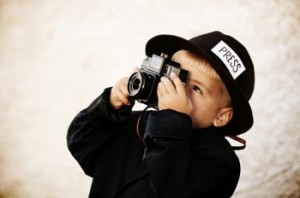 Another idea from Belgium…Carine says it gives children a chance to reflect on the things that happened during a day and provides an opportunity for individuals to share their personal perspective on the different activities they have engaged in. It also helps children learn about how their day is structured. She adds “And it’s always great to see what kids choose to put in their photos!”
Another idea from Belgium…Carine says it gives children a chance to reflect on the things that happened during a day and provides an opportunity for individuals to share their personal perspective on the different activities they have engaged in. It also helps children learn about how their day is structured. She adds “And it’s always great to see what kids choose to put in their photos!”
The children play photographer!
“Once a week we choose a child to be the photographer for a day. They get a special cap and a card with “REPORTER” on it on a piece of ribbon around their neck. This child can take whatever pictures they want for a day (or half a day if you have a lot of children). During whole class activities in a circle, I restrict them to the first few minutes otherwise it can get irritating for the teacher and distracting for the other children. However, they can take pictures when the class is doing group work, during lunch time and breaks and when they are playing outside.
Preferably before the end of the day, upload the photos onto a computer and show them to your class on the interactive white board. They always find it really hilarious (personally, I do not understand what is funny about a blurry face, but well …)! Let the reporter talk about the pictures. You might need to help. Let all the children reflect in a positive way.
(NB In the beginning probably more than half of them will fail – there will be too many pictures, the photographer will have wobbled the camera or forgotten to remove the lens cap! But a good lesson for the next time of course! Talk about how the picture could be improved)
Nic has tried this and written it up as a lesson with some extra activities
This post is also available in: Italian, Spanish, Romanian, Welsh




 English
English Nederlands
Nederlands Deutsch
Deutsch Italiano
Italiano Español
Español Português
Português Română
Română Cymraeg
Cymraeg
We tested this exercise with 4-5-6-year-olds in a school in Antwerp.
Toddlers liked taking pictures of what they were doing in and outside of the classroom. They also learned to take responsibility for the camera and felt very important with their new assignment!
However, sometimes they lost interest and we had to remind them to keep taking pictures. We also made sure plenty of children got the chance to be a reporter (one in the morning, one after playtime, one in the afternoon,…). They enjoyed it and liked showing us the pictures they had made.
We saw a lot of nice pictures at the end of the day. Some children had taken very clear pictures giving us an overview of what we had been doing. Others had taken pictures of less sharp objects, e.g. pictures on the wall or parts of it, chair legs, some toddler’s ear, .. the results were quite fun.
We used the clearest pictures to run through the things that we did that day, it is a very convenient tool to look back at a day’s work.
Great feedback! We’ve found that the choice of digital camera for this age group makes a difference as well. There are two we especially like. The Lego camera (about €40) they liked because it looks fun – and also it has Lego bricks top and bottom so they can build tripods and other stuff. This was a good way of keeping the toddlers ‘engaged’ when they got bored with taking pictures. The downside is that it only has a digital zoom but for that age group, this is really not a problem. The other one which the kids liked was the Vtech Kidizoom. Apart from the fact it comes in sparkly Barbie pink and a boyish equivalent, it has two viewfinders – one for each eye, and is designed to be held with two hands. We found that little ones have difficulty in coping with just using one eye to look through a viewfinder and they find it hard to get the hang of digital displays. Basically, the quality of the pictures was much better with the Kidizoom. Costs about the same as the Lego one.
Anyway, really glad you tried it out and told us how it went. Keep us posted on anything else you try or any other ideas you have.